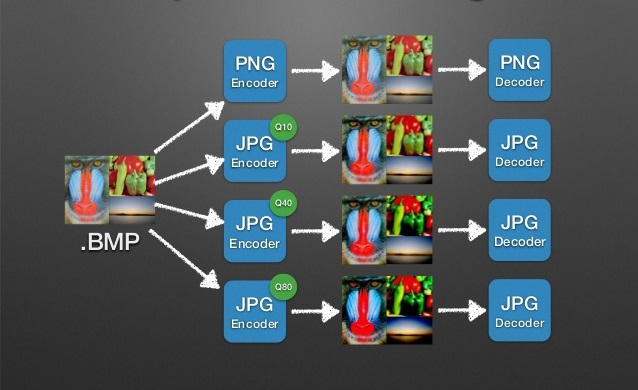What is a Codec :
- Codec stands for Code / Decode.
- It is basically a computer program that encodes data to a specified format.
- A codec encodes a datastream or signal for transmission, storage or encryption, or decodes it for playback or editing. we have to use same codecs at the encoder and decoder.
- Codecs are used in videoconferencing, streaming media, and video editing applications.
- The Image codec is a method of comression/decompression of image files or image data.
- There are various kinds of image codecs available. They have different specification and application in various fields.
- The various software image codecs are :
- Bmp
- Gif
- JPEG
- JPEG2000
- MJPEG
- TIFF
- PNG
- WBMP
- Pros:
- Good photo quality.
- Bitmap codecs may translate well to dot-format output devices such as CRTs and printers.
- Cons:
- Bmp codecs are limited to rgb images.
- These codecs does not support effective image compression. It's also not supported well across multiple platforms.
- Pros:
- This codecs allows you to create transparent, interlaced, and animated graphics for the Web.
- When compressing no image information will be loss.
- This codec is universally supported by all graphical browsers.
- Cons:
- This codec is not good for photographic images due to limited(256) number of colors used.
- Pros:
- Picture quality is generally good.Generally it is memory efficient.
- It works very well for "slide-show" movies that have very low frame rate.
- Cons:
- Single Resolution & Single Quality.
- NO lossless capability.
- Pros:
- improved coding efficiency & Full quality scalability.
- From lossless to lossy at different bit rate
- Cons:
- Requires more in memory compared to JPEG.
- Requires more computation time.
- Pros:
- compression is ‘lossless’, you do not lose color information as you compress the file smaller.
- It is a best one for creating complex live transparency, high-color graphics, and better compressed low-color graphics.
- Cons:
- It does not suport animation.
- It has lower quality than TIFF.

